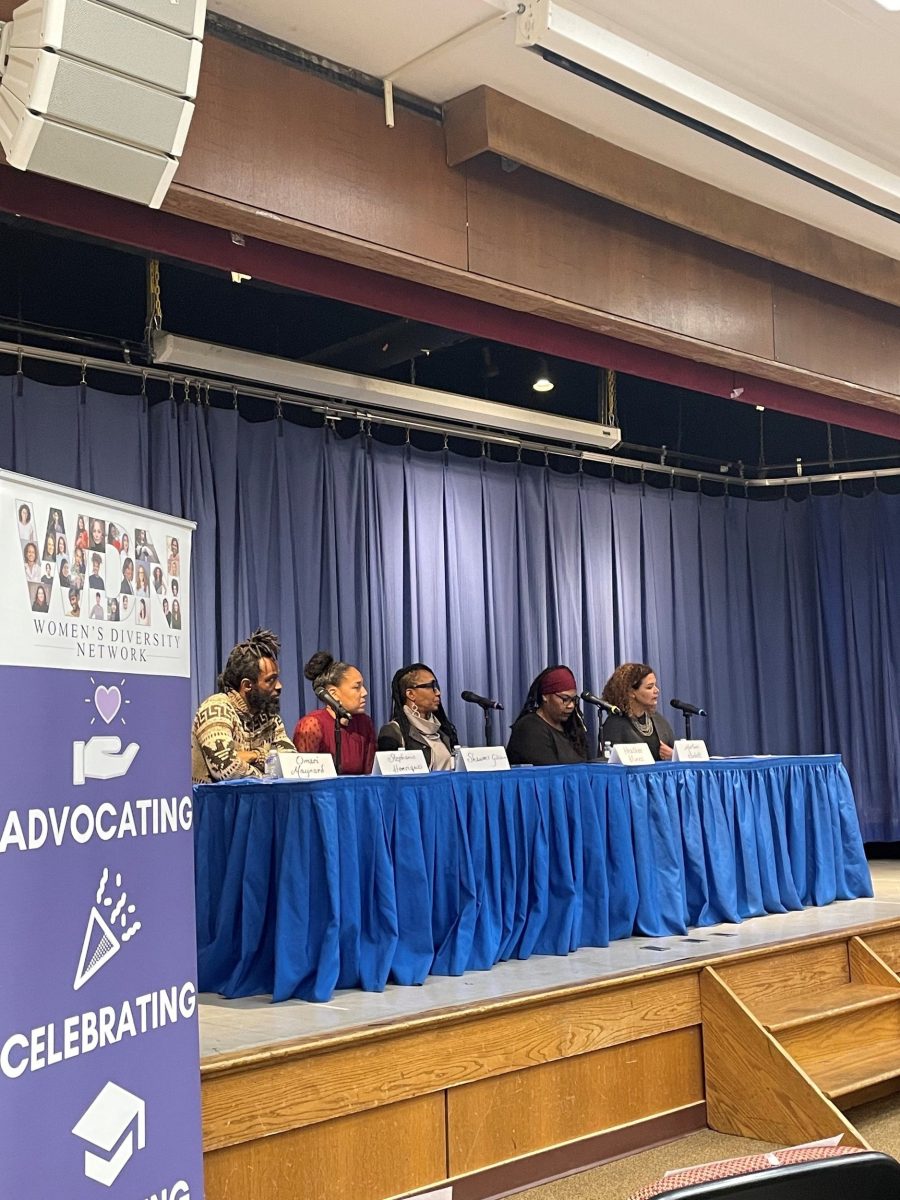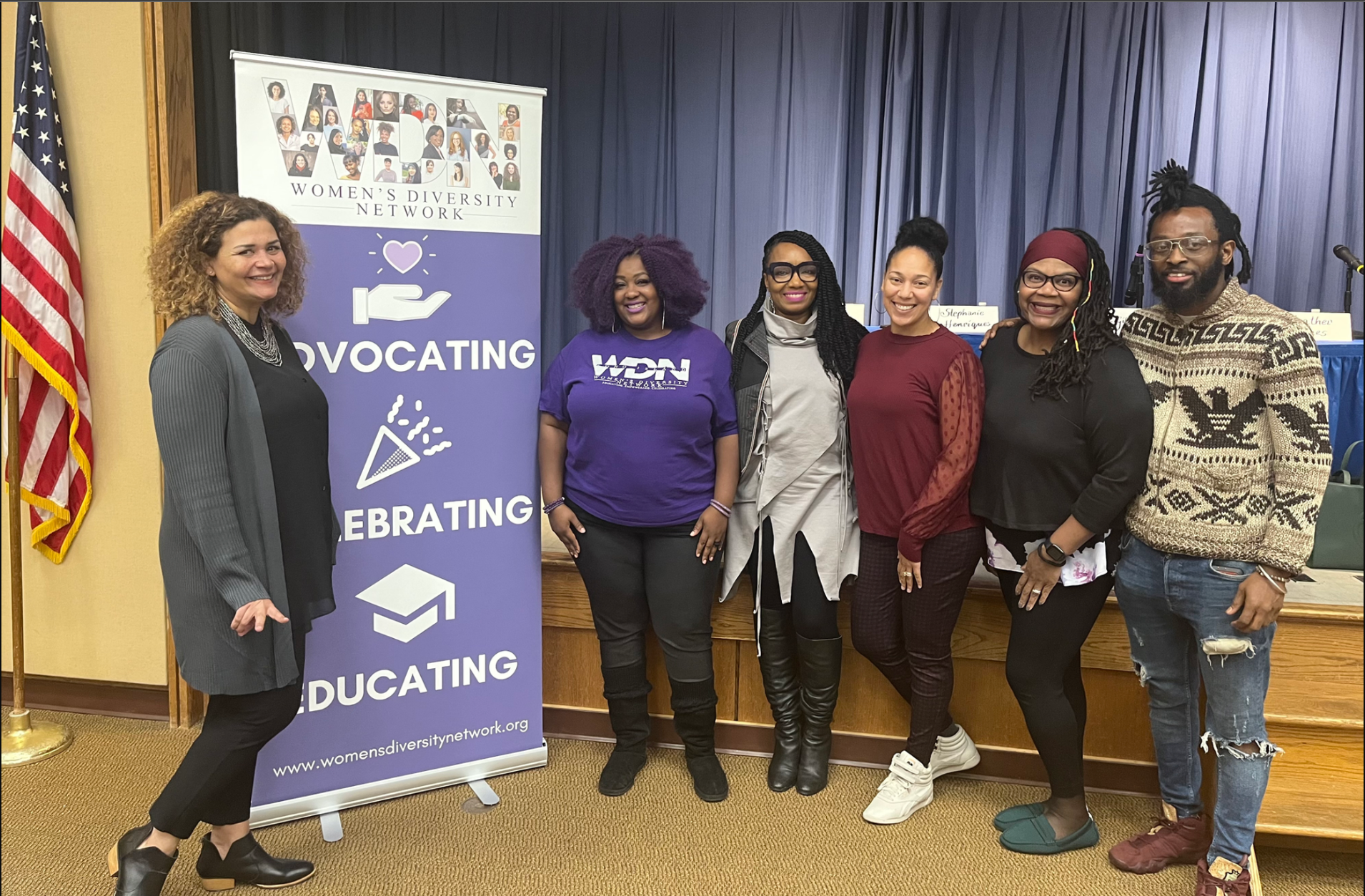The cast of the award-winning documentary partake in a panel discussion led by Hofstra professor Martine Hackett. // Photo courtesy of the Women’s Diversity Network.
Racial disparities in maternal and infant health are prevalent in the United States’ healthcare systems. Paula Eiselt and Tonya Lewis Lee’s passionate and award-winning documentary “Aftershock,” released in 2022, sheds new light on maternal health, as the movie addresses the alarming maternal mortality rate among Black women.
Through their documentary, Eiselt and Lewis Lee have reignited the examination of the Black maternal health epidemic and have sparked discussions among many activist groups and public health organizations across the U.S.
One such organization, the Women’s Diversity Network (WDN), hosted a viewing and panel discussion of “Aftershock” on Nov. 28. The event was co-sponsored by Hofstra University and Planned Parenthood of Greater New York.
Martine Hackett (left), Shanequa Levin, Shawnee Gibson, Stephanie Henriques (center), Heather Hines and Omari Maynard (right). // Photo courtesy of the Women’s Diversity Network
“WDN has a maternal justice coalition that deals with making lives better and having better health outcomes for pregnant people and women,” said Shanequa Levin, founder and CEO of WDN.
“Black women are four to five times more likely to die of pregnancy-related causes than white, Hispanic or Asian women,” said Martine Hackett, associate professor of population health at Hofstra. “In over 60% of these cases, the deaths were preventable.”
“Aftershock” explores the factors, such as structural racism and variation in quality healthcare, that contribute to this disparity. The film follows two individuals and their preventable deaths caused by childbirth complications and Eislet and Lewis Lee’s journey to gain justice as they unite with activists, physicians and birth workers, forming new communities to fight one of the most pressing epidemics.
The documentary opens with video clips of 30-year-old Shamony Gibson, who passed in October 2019 after the birth of her son. Gibson’s partner, Omari Maynard and Gibson’s mother, activist, co-founder and CEO of Spirit of a Woman Leadership Development Institute, Shawnee Gibson, are seen processing the events and working through their new life following the tragic death.
The following year, 26-year-old Amber Rose Isaac died due to an emergency cesarean section. Maynard and Bruce McIntyre, Isaac’s partner, formed a brotherhood and began their fight for justice for their partners and the entire community impacted by the Black maternal mortality epidemic.
According to Eiselt and Lewis Lee, “Aftershock” also explores how these families “seek justice through legislation, medical accountability, community and the power of art.” Furthermore, it introduces topics such as the brotherhood of surviving Black fathers who are left to navigate parenthood, the work and practice of midwives and doulas and the physicians challenging institutional reform.
Similar to a midwife, a doula provides physical and emotional support during pregnancy and labor.
Following the screening, Hackett led a panel discussion consisting of members from the documentary on the implications of the film.
Maynard began the discussion by commenting on the commonality of Black women experiencing maternal mortality and morbidity.
“From just the business side of birth, we take c-sections so lightly, and we feel like it is very common and has a sense that it’s supposed to happen,” Maynard said. “Unfortunately, that’s not the case.”
While the importance of having an advocate in the medical room during pregnancy and the period of labor was highlighted in the film, equally important were the practices of these families and of the African American community.
“We are just restoring indigenous practices, African-centered ways of just being,” Gibson said. “Community was a major conduit for our healing process. The aftershock ripples are that people are awakening to something – the power of the womb, the womb wisdom. That just didn’t exist before – it’s all science. That spirit is science; ritual is science, storytelling is action, grieving is action.”
The film also analyzes the historical perspective of the perpetual violence against Black women and their bodies: specifically, the crude ways in which surgical methods and the field of gynecology were developed through experimenting on the bodies of enslaved Black mothers.
“Just being the spiritual being that I am, I am very conscious of our ancestors being deeply pleased that their stories, the untold stories, their unceremonious deaths and their losses are told,” Gibson said. “These stories are being told unapologetically and that the truth is out there whether people want to ingest it or not.”
During these periods of pregnancy on plantations, Black midwives became essential figures in aiding with births for both Black and white women.
Heather Hines, a full-scope practicing midwife and associate clinical professor at Stony Brook University’s School of Nursing’s Midwifery Program, discussed the modern-day implications of midwifery education.
“There are 45 programs in the U.S. that have midwifery, and out of those 45 … there are less than five brown or Black program directors,” Hines said. “I happen to be one of them. Midwifery care is a model of care that has longer visits; we educate, we promote, we empower. You can’t do that in a medical model [where] you’re only technically allowed to see a patient for 10 minutes.”
“We know that when you walk into hospitals, there’s obviously going to be a power dynamic that’s going to exist,” said Stephanie Henriques, a social services strategist, licensed social worker and doula. “We’ve got our physicians and clinicians and then our birthing person and our doulas.”
The film’s impact resounded in attendees as they noted its importance.
“It is a really important event that discusses issues affecting the community,” said community member and social worker Kenya Jones. “Hopefully, I’ll be able to share more information with people and learn how to prevent it and help people.”
Some attendees even connected with the challenges of receiving proper health care. “My mom purposely stayed in Ecuador to give birth to me and refused to go back to the U.S. because she didn’t trust hospitals,” said Dorothea Armijos, a senior journalism major. “And she’s a white woman, so imagine that [mistrust] amplified in minority spaces, specifically Black spaces.”
Hackett urges individuals to watch the film, which can be streamed on Hulu. “Viewers will learn about the crisis of maternal mortality and what the consequences are for maternal deaths on the families left behind, [and] about advocacy efforts that have been sparked by the deaths of these new mothers,” Hackett said.
For those seeking to learn more about maternal health, Hackett advises them to join the Maternal Justice Coalition that serves Long Island. Additional resources can be found from the Women’s Diversity Network and Birth Justice Warriors.








